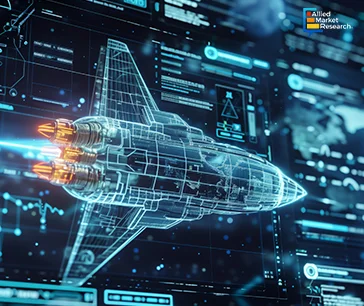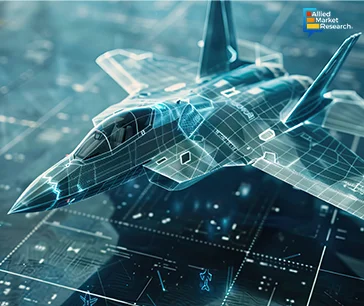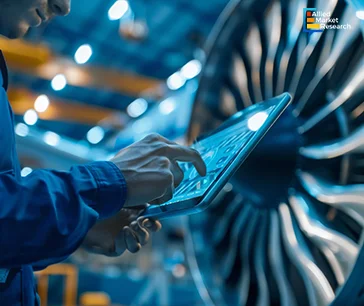Table Of Contents
- Mergers and acquisitions propelling the growth rate of the sector in Q2 2024
- Revolutionary innovations and partnerships creating wider scope for the domain
- High-impact technological advancements opening new avenues for the sector
- Other developments and upcoming trends transforming the landscape of aerospace and defense
- Finishing up

Lalit Janardhan Katare

Koyel Ghosh
Transformative Innovations and Synergistic Partnerships Propel Aerospace & Defense Growth in Q2 2024

The aerospace and defense sector has witnessed significant transformation over the years, driven by rapid advancements in technology, increasing international competition, and evolving security dynamics. Innovations in materials science, propulsion systems, and artificial intelligence have paved the way for the development of next-generation aircraft, spacecraft, and defense systems. Moreover, emerging geopolitical issues and threats necessitate a robust and agile defense infrastructure. This evolving landscape presents both challenges and opportunities, demanding a strategic approach to innovation, collaboration, and policymaking to ensure global security and advance modern technologies.
Along with these factors, the dynamic nature of the domain has also contributed to the growth of the sector, especially in the second quarter of 2024. Many businesses in this field have launched innovative products and services and invested in technological advancements. Also, to compete with multinational giants, new entrants in the sector have signed partnership and M&A agreements. These developments created new growth opportunities in Q2 2024.
Mergers and acquisitions propelling the growth rate of the sector in Q2 2024
Many leading players in the sector have signed merger and acquisition agreements with other companies to gain an advantage over their peers. In June 2024, Honeywell, an American publicly traded, multinational conglomerate corporation, announced its intention to acquire CAES Systems Holdings LLC, a leading provider of mission-critical electronic solutions for the United States aerospace and defense industry. This acquisition has enhanced Honeywell's defense technology solutions across land, sea, air, and space, including new electromagnetic defense solutions for end-to-end radio frequency (RF) signal management. Under this agreement, the companies have envisioned strengthening their positions in key platforms platforms that include F-35, EA-18G, AMRAAM, and GMLRS, along with introducing offerings on new platforms such as Navy Radar (SPY-6) and UAS and C-UAS technologies.

In June 2024, Cognizant, an American multinational information technology services and consulting company, signed a definite agreement to acquire Belcan, LLC, a leading global supplier of Engineering Research & Development (ER&D) services. With this agreement, Cognizant has planned to expand its ER&D capabilities by taking a leadership approach in the field of IoT and digital engineering. Along with Belcan, the company aims to strengthen its position in the aerospace & defense sector with a blue-chip client base, deep domain expertise, and significant technological capabilities with over 6,500 engineers and technical consultants.
In April 2024, Thales, a French aerospace and defense manufacturer, acquired Cobham Aerospace Communications, a renowned supplier of advanced communication and connectivity systems. Through this agreement, Thales plans to complement its avionics portfolio and gain a significant position in the dynamic landscape. The company has strengthened its offering and positioning within the connected avionics systems, embracing the upcoming revolution in aircraft connectivity and communication.
Revolutionary innovations and partnerships creating wider scope for the domain
To align with the emerging security standards globally, several leading companies and new entrants have made strategic partnerships and brought innovations to take an edge over their competitors. For instance, in June 2024, Adani Defense and Aerospace, a leading Indian-based defense and aerospace manufacturing corporation, signed an agreement with EDGE Group, a global technology and defense organization based in the United Arab Emirates, to create a global platform to boost defense aerospace strengths. Under this agreement, the platform utilizes the strengths of both entities by combining their product portfolios. This includes evaluating EDGE’s and Adani’s core product domains, including missiles and weapons covering airborne, surface, infantry, ammunition, and air defense products, platforms, and systems covering unmanned aerial systems. This partnership showcases the commitment of India and the UAE to advance technological prowess and promote bilateral defense cooperation.
In June 2024, AeroShul Technologies, an autonomous systems and intelligent solutions developer, teamed up with Eesti Arsenal OÜ in Estonia, a renowned arms manufacturing company, to boost aerospace innovation. This MoU signifies the commitment of entities to collaborate for the development and manufacturing of defense technologies. Through this collaboration, India and Estonia aim to strengthen their defense capabilities by focusing on military training, cyber defense, technology exchange, and strategic dialogue.
In April 2024, Eve Air Mobility, an electric vertical takeoff and landing (eVTOL) aircraft developer, partnered with Korea Aerospace Industries (KAI), a South Korean aerospace and defense company. Under this agreement, KAI has provided pylons for Eve’s innovative eVTOL aircraft. Pylons play a crucial role in supporting the electric power units and lift propellers of the aircraft, making KAI’s expertise invaluable to Eve’s project. Johann Bordais, CEO of Eve, said that this partnership indicates Eve’s commitment to assembling a robust network of suppliers to ensure the seamless development and production of its eVTOL aircraft.
Ingenious product and service launches generating numerous opportunities for the sector

As part of the plan to increase their revenue share in the aerospace and defense sector, many multinational corporations have launched innovative products and services in Q2 2024. In May 2024, DFS Aviation Services GmbH (DAS), a subsidiary of DFS Deutsche Flugsicherung GmbH, introduced the cloud-based system - “PHOENIX Web Innovation” for air traffic control at Memmingen airport. This first-of-its-kind, cutting-edge air traffic control system operates entirely on public cloud infrastructure and represents a in the air traffic control industry. It utilizes state-of-the-art mechanisms and acts as an enhanced information tool for smaller airports.
In April 2024, Wright Electric, a developer of electric propulsion for large commercial aircraft, launched its Wright Electric Aircraft Engine Test Cell (WEAETC) to analyze the performance of megawatt-class electric aircraft propulsion systems. Through testing and analysis at the WEAETC, Wright aims to validate the thermal and dynamic stability of its Electric Propulsion Unit (EPU), which is notably quieter than conventional engines. The EPU is planned to be installed under the wings of tested flights, paving the way for advancements in electrification technologies.
In April 2024, ZeroAvia, an American hydrogen-electric aircraft developer, announced to offer promising components designed for hydrogen-electric engines compared to other clean aviation components so far. This move of ZeroAvia allows it to build upon the multi-billion-dollar business for its hydrogen-electric powertrain family, maximizing the company’s investment in R&D activities. Along with this, these new elements are also expected to help the company reduce the environmental impact of aviation. Key components offered by the company include advanced electric motors, silicon carbide inverters, low-temperature proton exchange membranes (LT-PEM), high-temperature-PEM, and aviation fuel compressors.
High-impact technological advancements opening new avenues for the sector
Innovation and technological advancements have been pivotal for the growth of the aerospace and defense domain in the second quarter of 2024. In May 2024, Airbus UpNext, a wholly owned subsidiary of Airbus, launched a new technological demonstrator to accelerate the maturation of superconducting technologies for use in electric propulsion systems. This demonstrator represents the future of hydrogen-powered aircraft. It integrates a two-megawatt-class superconducting electric propulsion system cooled by liquid hydrogen via a helium recirculation loop. It is designed to improve the performance of the propulsion system, converting into significant weight and fuel-saving potential.
In April 2024, IHI Corporation, a Japanese engineering corporation, launched two initiatives related to Japan’s Next-Generation Aircraft Development Project to redefine hydrogen fuel cell and aircraft electrification technologies. The corporation scaled up its previously designed hydrogen fuel cell system with a four-megawatt-class powertrain to power a 40-seater aircraft, offering zero emissions. Through these initiatives, the company has planned to advance its core technologies to build a power control system. This is achieved by integrating hybrid electric propulsion and thermal and air management systems together, along with employing an air conditioning device for airframes.
In April 2024, Westwell, a leading intelligent solutions provider, signed a MoU with Hong Kong Air Cargo Terminals Limited., Hong Kong's largest independent cargo handler, to collaborate on the introduction of a new energy-autonomous driving tractor, the Q-Tractor P40. With this agreement, both parties aim to develop autonomous vehicles without compromising safety. To design these highly advanced self-driving vehicles, Westwell plans to integrate artificial intelligence technology and clean energy, thus contributing to reduced environmental impact.
Other developments and upcoming trends transforming the landscape of aerospace and defense
In May 2024, the Indian Army stated that it was set to receive the first of two Israeli Hermes-900 Medium Altitude Long Endurance Unmanned Aerial Vehicles assembled by Adani Defense Systems and Technologies Limited (ADSTL) in India. Through this agreement, the Army contracted 48 Igla-S launchers, 100 missiles, 48-night sights, and one missile testing station under a ?260 crore contract.

In April 2024, Hanwha Aerospace signed an additional executive contract with the Polish Armaments Agency to supply 72 more Chunmoo Multiple Rocket Launcher Systems (MRLS). This contract signifies Hanwha Aerospace’s dedication to supporting the enhancement of security in Poland and the region, irrespective of political and societal changes. The 72 Polish Chunmoo Multi-Rocket launcher includes CTM-290, a long-range guided missile of Chunmoo and different launch modules of the MRLS.
In April 2024, The U.S. Navy assessed the eSTOL Aircraft of Electra, a renowned aircraft manufacturer, helps decarbonize aviation, for ship-based operations. Electra works with the U.S. Navy to define specific “contested logistics” use cases and to conduct a conceptual design study to evaluate how the hybrid-electric aircraft could be operated from the decks of ships. The eSTOL aircraft of Electra is designed to operate with ground rolls as short as 150 feet, addressing next-generation aviation logistics challenges.
Finishing up
The aerospace & defense domain is experiencing promising growth, propelled by continuous technological advancements and strategic global collaborations. Over the years, the sector has continuously demonstrated resilience and innovation, responding adeptly to emerging threats and opportunities. With significant investments in research and development, coupled with a focus on sustainable practices and advanced manufacturing, the sector is set to achieve new milestones in the upcoming years.
Along with this, mergers and acquisition agreements made by leading corporations in the sector have also contributed to the rise of the landscape. Product launches and technological advancements have helped businesses invest their capital in this domain, thereby creating new avenues of growth in the sector. Moreover, the compiled study offered by AMR about various promising developments in the landscape for Q2 2024, represents extensive growth of the sector with enhanced capabilities, improved security frameworks, and sustained economic contributions. Such developments are expected to shape the future of the sector with a safer and more advanced global landscape.
To gain insights into the dynamic aerospace and defense industry, reach out to our esteemed analysts here!

